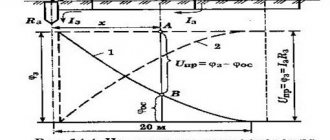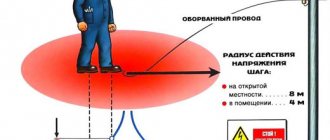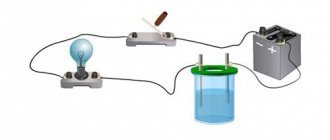Non-releasing current
What current is non-releasing current?
Document:
interstate standard GOST 12.1.009-76 “System of occupational safety standards. Electrical safety. Terms and definitions”, approved by Decree of the State Standard of the Republic of Belarus dated December 17, 1992 No. 3; entered into force as a state standard of the Republic of Belarus .
Non-releasing current is an electric current that, when passing through a person, causes irresistible convulsive contractions of the muscles of the arm in which the conductor is clamped.
An increase in current above the perceptible threshold causes muscle cramps and painful sensations in a person, which intensify with increasing current and spread to larger and larger areas of the body.
Thus, at 3–5 mA (50 Hz), the effect of the current is felt by the entire hand; at 8–10 mA, the pain sharply intensifies and covers the entire arm, accompanied by involuntary contractions of the muscles of the arm and forearm.
At 10–15 mA (50 Hz), the pain becomes barely bearable, and the cramps of the arm muscles are so strong that the person is unable to overcome them. As a result, he cannot release his hand, in which the current-carrying part is clamped, and he finds himself as if chained to it.
An electric current that, when passing through a person, causes irresistible convulsive contractions of the muscles of the arm in which the conductor is clamped is called a non-releasing current, and its smallest value is a threshold non-releasing current.
The threshold non-releasing current can be conditionally considered safe for humans, since it does not cause immediate damage. However, with prolonged passage, the current increases due to a decrease in body resistance, as a result of which pain increases and serious disturbances in the functioning of the lungs and heart can occur, in some cases death occurs.
With a constant current, strictly speaking, there are no non-releasing currents, i.e. a person, at any current value, can independently unclench the hand in which the conductor is clamped, and thus break away from the current-carrying part. However, at the moment of separation, painful muscle contractions occur, similar to those observed with approximately the same alternating current.
The values of threshold non-releasing currents vary among people. They also differ between men, women and children. Their average values are:
– for men – 16 mA at 50 Hz and 80 mA at constant current;
– for women – 11 and 50 mA, respectively;
– for children – 8 and 40 mA, respectively.
A current exceeding the threshold non-releasing current increases convulsive muscle contractions and pain, which spread to a wider area of the human body.
A current of 25–50 mA at 50 Hz affects the muscles not only of the arms, but also of the torso, incl. on the muscles of the chest. As a result, breathing movements of the chest become very difficult. In case of prolonged exposure to this current, breathing may become impossible, after which death from suffocation occurs after some time. This current simultaneously causes a narrowing of the blood vessels, which leads to an increase in blood pressure and difficulty in the functioning of the heart. Prolonged exposure to current causes a weakening of the heart's activity and, as a result, loss of consciousness.
A current greater than 50 mA up to 100 mA (50 Hz) acts much stronger than a current of 25–50 mA, i.e. disturbances in the functioning of the lungs and heart appear after a shorter period of time. With this current, as with a current of 25–50 mA, the lungs are usually the first to be affected (in time), and then the heart.
Ella Goryunova , leading labor protection engineer at OJSC "Managing
The effect of electric current on the human body. Various currents
Threshold palpable, non-releasing and fibrillation currents
Usually a person begins to feel the irritating effect of alternating current of industrial frequency 50 Hz at a value of 0.6-1.5 mA and direct current of 5-7 mA. These currents are called sensible threshold currents
. They do not pose a danger to humans, and a person can independently disconnect from the circuit.
With alternating currents of 5-10 mA, the irritating effect of the electric current becomes stronger, muscle pain and involuntary contraction appear. At currents of 10-15 mA, the pain in the muscles becomes so severe that the person is no longer able to independently free himself from the action of the current (he cannot unclench his hand, throw the wire away from him, etc.). Alternating currents of 10-15 mA and above and direct currents of 50-80 mA and above are called non-releasing currents
.
Alternating current of 25 mA and higher (depending on where the person touched the live parts - depending on the path of the current) affects the muscles of the chest, which can lead to respiratory paralysis and cause death.
An electric current of about 100 mA or more at a frequency of 50 Hz and 300 mA or more at a constant voltage in a short time (1-2 s) affects the human heart muscle and causes fibrillation. These currents are called fibrillation currents
.
Currents of more than 5 A cause paralysis of the heart and breathing, bypassing the stage of cardiac fibrillation. If the current flows for a long time (several seconds), severe burns and destruction of human body tissues occur.
Sensible current
- an electric current that causes noticeable irritation when passing through the human body.
Non-releasing current
- an electric current that, when passing through the human body, causes irresistible convulsive contractions of the muscles of the hand in which the wire is clamped.
Fibrillation current
- an electric current that causes cardiac fibrillation when passing through the human body.
The smallest values of these currents are called threshold
.
Threshold values of palpable, non-releasing, fibrillation currents obtained as a result of experimental studies are given in Table 1.1.
Table 1.1. Threshold values of palpable, non-releasing and fibrillation currents
AC 50 Hz
Direct current, mA
Path of current flow through a person
The path of electric current flow through the human body is of great importance in the outcome of the injury. The most severe consequences will be if the heart, chest, brain and spinal cord are in the path of the current (current path: arm-legs, arm-arm, neck-legs, neck-arm).
The data given in Table 1.1 corresponds to the passage of current through a person along the arm-arm or arm-leg path.
From Table 1.1 it is also clear that the impact on a person of direct and alternating current is different - alternating current of industrial frequency is more dangerous than direct current of the same value.
Duration of exposure to electric current
The duration of current flow through a person is important for assessing the risk of electric shock.
. As the duration of the course increases, the likelihood of a severe or fatal outcome increases. Short-term (several hundredths of a second) exposure to even significant currents (100 A or more) may not have serious consequences. The influence of the duration of current passage through the human body on the outcome of the injury can be assessed by the formula:
where: Ih is the current passing through the human body, mA, t is the duration of current passage, s.
This follows from the fact that with an increase in the passage time of the current, the resistance of the human body decreases, since this increases the local heating of the skin, which leads to the expansion of its vessels and an increased supply of blood to this area and an increase in current release.
In Figure 1.2. An experimentally obtained graph is shown that determines the degree of danger of injury to a person when exposed to electric current of various values for various time intervals.
Fig. 1.2 Graph of 0.5% probability of cardiac fibrillation.
It follows from the graph that for a pair of current values and the duration of its flow located outside the shaded area, the probability of fibrillation is higher than 0.5%.
The dependence shown in Fig. 1.2., can be expressed by the formula:
where: If.0.5%
— current causing fibrillation with a probability of 0.5%, mA;
t
is the duration of the flow of electric current through the human body, s.
Individual properties of a person
It has been established that physically healthy and strong people can more easily withstand electric shocks. Persons suffering from diseases of the skin, cardiovascular system, internal secretion organs, lungs, and nervous diseases are characterized by increased susceptibility to electric current.
Environmental conditions
The state of the environment significantly affects the risk of electric shock. Dampness, conductive dust, caustic vapors and gases have a destructive effect on the insulation of electrical installations, and high ambient temperatures reduce the electrical resistance of a person, which further increases the risk of electric shock. The impact of current on a person is aggravated by conductive floors and metal structures located close to electrical equipment that are connected to the ground, since when simultaneously touching these objects and the body of electrical equipment that accidentally becomes energized, a dangerous current will flow through the person.
Human exposure to electromagnetic fields
When operating high-voltage electric power plants (330 kV and above) - open switchgears (OSD), overhead power lines (OHT), it is necessary to take into account the negative impact of the electromagnetic field on humans. Biologically active are electric and magnetic fields whose intensity exceeds permissible values.
The maximum permissible level of intensity (E) of the acting electric field (EF) is 25 kV/m. It is not allowed for a person to be in an electrical field with a voltage of more than 25 kV/m without the use of personal protective equipment.
When the EF voltage level is over 5 to 20 kV/m, the permissible stay time of people is calculated using the formula:
where: E is the intensity level of the influencing EF (kV/m); T - permissible residence time (h)
If the electrical voltage level does not exceed 5 kV/m, people are allowed to stay in the electrical unit during the entire working time (8 hours).
The permissible intensity (N) or induction (B) of the magnetic field (MF) for conditions of general (on the whole body) and local (on the limbs) influence, depending on the stay in the MF, is determined in accordance with Table 1.2.
Table 1.2. Permissible magnetic field levels
Stay time, hours
Permissible MP levels H(A/m)/B(μT) when exposed to
Source
Threshold perceptible non-releasing and fibrillation currents
Threshold palpable, non-releasing and fibrillation currents
Usually a person begins to feel the irritating effect of alternating current of industrial frequency 50 Hz at a value of 0.6-1.5 mA and direct current of 5-7 mA. These currents are called sensible threshold currents
. They do not pose a danger to humans, and a person can independently disconnect from the circuit.
With alternating currents of 5-10 mA, the irritating effect of the electric current becomes stronger, muscle pain and involuntary contraction appear. At currents of 10-15 mA, the pain in the muscles becomes so severe that the person is no longer able to independently free himself from the action of the current (he cannot unclench his hand, throw the wire away from him, etc.). Alternating currents of 10-15 mA and above and direct currents of 50-80 mA and above are called non-releasing currents
.
Alternating current of 25 mA and higher (depending on where the person touched the live parts - depending on the path of the current) affects the muscles of the chest, which can lead to respiratory paralysis and cause death.
An electric current of about 100 mA or more at a frequency of 50 Hz and 300 mA or more at a constant voltage in a short time (1-2 s) affects the human heart muscle and causes fibrillation. These currents are called fibrillation currents
.
Currents of more than 5 A cause paralysis of the heart and breathing, bypassing the stage of cardiac fibrillation. If the current flows for a long time (several seconds), severe burns and destruction of human body tissues occur.
Sensible current
- an electric current that causes noticeable irritation when passing through the human body.
Non-releasing current
- an electric current that, when passing through the human body, causes irresistible convulsive contractions of the muscles of the hand in which the wire is clamped.
Fibrillation current
- an electric current that causes cardiac fibrillation when passing through the human body.
The smallest values of these currents are called threshold
.
Threshold values of palpable, non-releasing, fibrillation currents obtained as a result of experimental studies are given in Table 1.1.
Table 1.1. Threshold values of palpable, non-releasing and fibrillation currents
AC 50 Hz
Direct current, mA
Path of current flow through a person
The path of electric current flow through the human body is of great importance in the outcome of the injury. The most severe consequences will be if the heart, chest, brain and spinal cord are in the path of the current (current path: arm-legs, arm-arm, neck-legs, neck-arm).
The data given in Table 1.1 corresponds to the passage of current through a person along the arm-arm or arm-leg path.
From Table 1.1 it is also clear that the impact on a person of direct and alternating current is different - alternating current of industrial frequency is more dangerous than direct current of the same value.
Duration of exposure to electric current
The duration of current flow through a person is important for assessing the risk of electric shock.
. As the duration of the course increases, the likelihood of a severe or fatal outcome increases. Short-term (several hundredths of a second) exposure to even significant currents (100 A or more) may not have serious consequences. The influence of the duration of current passage through the human body on the outcome of the injury can be assessed by the formula:
where: Ih is the current passing through the human body, mA, t is the duration of current passage, s.
This follows from the fact that with an increase in the passage time of the current, the resistance of the human body decreases, since this increases the local heating of the skin, which leads to the expansion of its vessels and an increased supply of blood to this area and an increase in current release.
In Figure 1.2. An experimentally obtained graph is shown that determines the degree of danger of injury to a person when exposed to electric current of various values for various time intervals.
Fig. 1.2 Graph of 0.5% probability of cardiac fibrillation.
It follows from the graph that for a pair of current values and the duration of its flow located outside the shaded area, the probability of fibrillation is higher than 0.5%.
The dependence shown in Fig. 1.2., can be expressed by the formula:
where: If.0.5%
— current causing fibrillation with a probability of 0.5%, mA;
t
is the duration of the flow of electric current through the human body, s.
Individual properties of a person
It has been established that physically healthy and strong people can more easily withstand electric shocks. Persons suffering from diseases of the skin, cardiovascular system, internal secretion organs, lungs, and nervous diseases are characterized by increased susceptibility to electric current.
Environmental conditions
The state of the environment significantly affects the risk of electric shock. Dampness, conductive dust, caustic vapors and gases have a destructive effect on the insulation of electrical installations, and high ambient temperatures reduce the electrical resistance of a person, which further increases the risk of electric shock. The impact of current on a person is aggravated by conductive floors and metal structures located close to electrical equipment that are connected to the ground, since when simultaneously touching these objects and the body of electrical equipment that accidentally becomes energized, a dangerous current will flow through the person.











